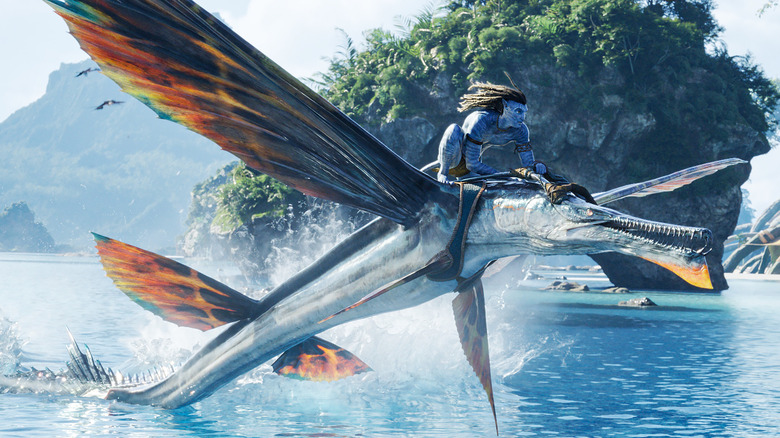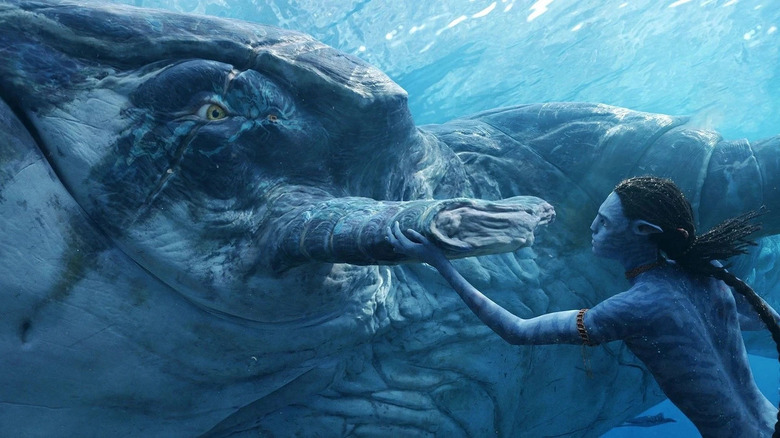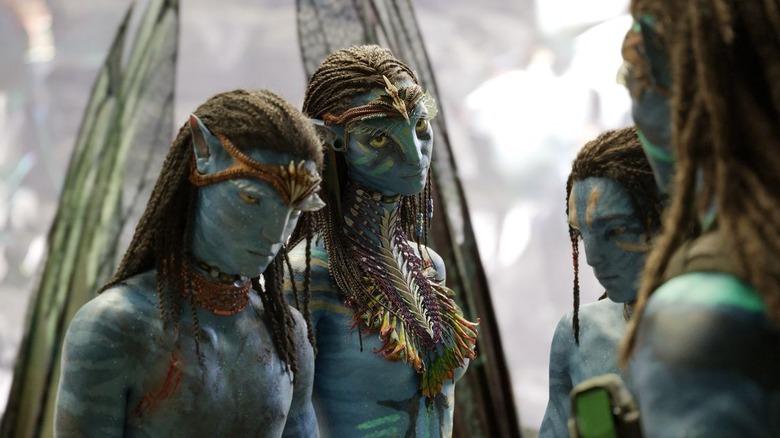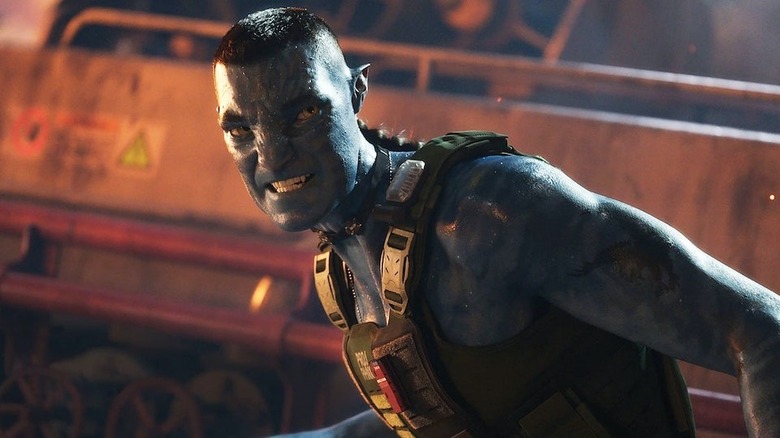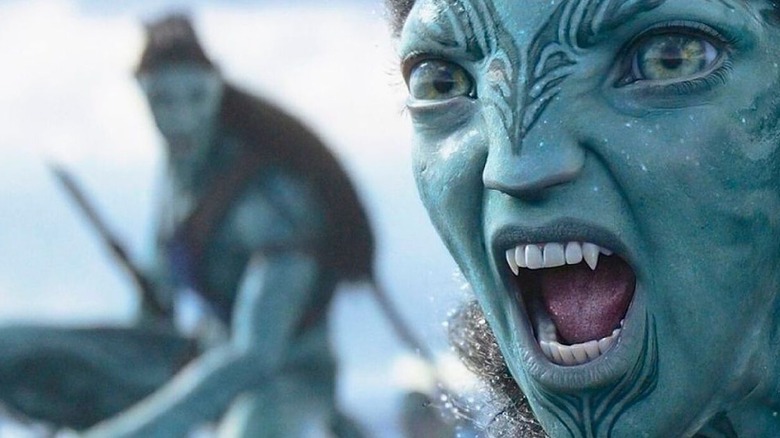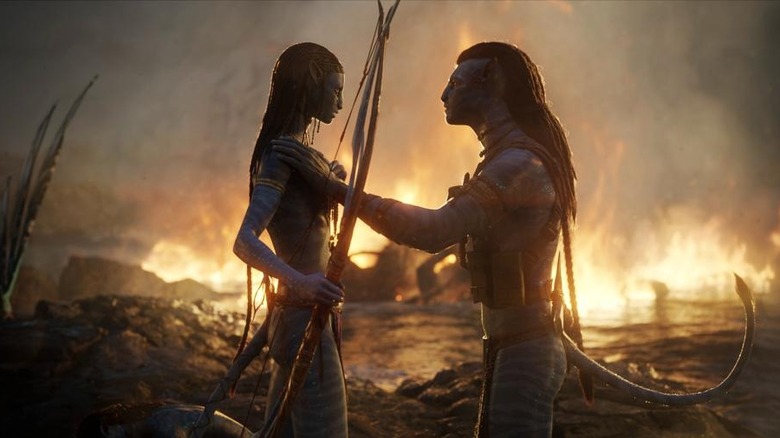Composer Simon Franglen Talks Avatar: The Way Of Water And Planting Seeds For Future Sequels [Exclusive Interview]
Before "Avatar: The Way of Water," composer Simon Franglen was intimately familiar with the "Avatar" universe. Franglen collaborated with the late, great James Horner on the first film and composed music for Walt Disney World's Avatar theme park land. With "Avatar: The Way of Water," the composer expands the musical landscape of Pandora while also honoring the work of Horner, whose scores for "Titanic" and several other films were produced by Franglen.
For James Cameron's sequel, the composer brought in musicians and instruments from all over the world to continue to define Pandora and its characters. It's a sweeping score that's as majestic as the images, both familiar and otherworldly. It's "relentless," as Franglen puts it — just the way Cameron wanted it. The composer's career outside of "Avatar" is another epic story for another day, but he's worked with the likes of Pink Floyd, Quincy Jones, Whitney Houston, and he created electronica for Howard Shore's scores for David Fincher's "Se7en" and David Cronenberg's "Crash." During a recent Zoom interview, Franglen talked to us about his journey with his "Avatar: The Way of Water" score and seeds he's planted for future sequels.
Note: This interview has been lightly edited for clarity and brevity.
'It is basically a boy and his dog'
James Cameron likes to raise the bar. For "Avatar: The Way of Water," how did you both want to push the envelope with the score?
One of the things we did was discuss what he felt succeeded and what didn't succeed in "Avatar." And this will be an ongoing thing. I know that we will probably do a dissection, shall we say, of the score for "Avatar 2" in a little time, and I have no doubt the same thing will happen with "Avatar 3." He does that for everything. He wants to try and say, "Well, how do we make the next one better?" I'm expecting that, and that is part of the process, to constantly find a new bar. With this one, there's whole new tribes, there's new vistas, there's the water, there are so many new elements. We needed to bring all of that into the music.
Musically, you give a real inner life to the creatures as well. How did you want to help create a personality for the animal life in the film?
There was a very, very specific discussion about this. For instance, Payakan, the great tulkun. Large amounts of this film are set underwater. Therefore, the music acts as sort of a narrator for you. It has to help that emotional flow. If we take that scene where Lo'ak first meets Payakan, one of the things that I wanted to do was give a sense of the joy of the two of them together. This is a man and his Labrador. The Labrador may be 300 tons and be smarter than him, remember, because the tulkun is smarter than the Na'vi, but it is basically a boy and his dog. There is that joy. In that scene, there is a flow from the point where Lo'ak wakes up on Payakan, and that bond was something that really needed to come gradually, and the music helped that.
Obviously once we went to the swimming scene, I wanted to give Payakan a grace and beauty, but also this almost balletic nature to him. Because again, he may be 300 tons, but when he swims in the water, there is this agile quality to the way that he swims. He needed his own theme. There's a theme for Payakan that I also used in the tulkun hunt and for the tulkun in general. It was based on the physics of how whales make music. This says something else about the detail we go to in "Avatar," is that sound designer Chris Boyes and I spent time with the lead whale specialist from UCLA who then talked us through how whales create their whale song.
As it happens, we thought we were going to have a tulkun song that was going to be part of this film. Like many things, you do things and then there's just not room for everything that you wanted to put in. But the physics of it came suddenly when I realized that it was this idea of a resonant chamber, and therefore you then start thinking about, "How do you make different notes?" And there's a thing in musicals called the circle of fifths, which is where you cut tubes, basically, down in size to get these different resonant notes. And that became my starting point for Payakan's theme, which was the idea of natural resonances within a body. Now, I've got it on cello and French horns. They're obviously western instruments, but the starting point was the physics of, "How would a tulkun make a noise?"
'I wanted the sense of mermaids or sirens calling them to the water'
What was your theme for family? Musically, what's the arc for it?
For the family theme, on page one of the script of "Avatar 2," it says, "Neytiri sings the songcord." The songcord was a specific concept that Jim had. As you've seen in the film, it has such an important role to play in terms of our story. That had to be something I had to write first. On December 7th, 2017, I read this. It had to be recorded by Zoe Saldaña in March, April 2018 because of the shooting schedule.
Once I got a melody going, and then I started working on the lyrical ideas, which I based on some concepts from indigenous tribes around the world to do with carrying light from a spark, that the life is a spark that becomes the dawn. And then the dawn, you carry the light through to the day and then the day goes to the sunset when you die. That was the concept for this lyric, which I wrote in Na'vi, the language of Pandora, because it needed to be grounded in the place. I couldn't just make it an English pop song or whatever.
Zoe sings that live; what you see on screen is her singing that live. That's not prerecorded in the studio, that's a live vocal in front of a hundred technicians. It's like any other line of dialogue in the film. I adapted my music to her live performance. And that then became the theme for the family. You hear it in "Leaving Home" as they're flying away. It's the same theme. It's a core tenet of this score I use throughout.
Even in the cue called "From Darkness to Light," you'll hear it. It's traced out a little bit in a slightly different way because I'm changing some inversions against that theme in a different way, but it is the same basic melody. Even in little cues like "Happiness Is Simple," you'll hear it played in a lighter fashion because this is a playful element of the family.
When we move out to the sea, we needed a theme for the Metkayina and their connection with water. And that became, I would say, "The Way of Water" theme. I use it for the first swim when they first jump into the water. It's the cue chord into the water. It has a longer line. You hear it in its full form in "The Tulkun Return." A big long tune with B section and everything else, but I tease it through other cues. "Into the Water," I wanted the sense of mermaids or sirens calling them to the water, that these beautiful voices come in as the kids jump into the water. The moment the Sully children hit the water, there is this wonder and you know can see that sense of the light and the fish and the staggering beauty of what they're seeing around them. I wanted to reflect that in this theme in terms of the voices calling them to the water.
'We don't have our Imperial March'
You contrast the awe well. There's such a sound of thundering terror in "A New Star" at the beginning. How did you want to create a sense of destruction and evil for the antagonists?
Jim said, "We don't have our 'Imperial March.' We need a baddies theme." And so, I wrote this thing that became the RDA theme. He said, "I want something brutal. I want something unsubtle. It has to be relentless." There is a sense that when they come, they're not messing around. They just come in and they stomp their way through. There is this sense of the relentlessness of it, that it's just a machine that stomps its way through. Musically, I had to do the same thing.
Jim didn't want it to have too much subtlety. Though this became something where I was using these low synthesizers along with lots of low brass, a really quite large brass section and also these big hits and then these angular, I will say, Herrmann-like strings at the top, so that I can leave the middle clear for the sound effects. Inside that, which we hear sometimes later, I actually wrote a subset of this, which is the Quaritch theme that you'll hear on occasion. They do fit like hand-in-glove. I don't do too much of it, but they are actually subsets of the same. They are cousins, shall we say. RDA and Quaritch have their own variations of the same thing.
For the world of "Avatar," what moments require silence?
It's fair to say a three hour, 12-minute film where I've got five minutes off, there isn't much silence. There were a couple of times where I stopped cues just for a breather. Every so often Jim said, "No, no, no, we need to keep the audience going here." He has a ridiculously great sense of pacing and he's never sentimental about the prettiest shots. We're talking about Payakan, and I said, "Jim, if you give me another 20 seconds... " "No, no, no, no, we're done with this. We're going to get onto the next bit."
Jim gives you stuff and then he immediately says, "Right, I'm going to take it away from you." There are moments, for instance, when the family is on the rock and a major event has happened and then we think we know where we are and then suddenly there is a conversation in the air and the whole tenor of what's happening completely changes. Jim doesn't believe in allowing you to ever feel like you know where you are going too much. He keeps pushing forward and forward to try and make it so that journey doesn't falter. I think the low boredom threshold is an essential part of a Jim Cameron film.
'We all wanted to honor James Horner's memory'
For the third act [action], you really hear the spirit of James Horner there, which was important for you. He always delivered such rousing scores for finales. How did you want to pay tribute to him there?
James Horner was a good friend of mine. He was one of my closest friends, and we wanted to bring some of the themes from "Avatar" into "Avatar 2." We all wanted to honor James' memory in what we were doing. It also made sense for the canon of films. We've got these five films. Why would you suddenly discard all the tunes from "Avatar"? For instance, where it was appropriate, I tended to do it more towards the beginning of the film because that's the one where we're doing that connective tissue from A1 to A2, that sort of, "Meanwhile, this is what happened." And so, when Jake and Neytiri go flying at night together and what we call "Date Night," that cue, then I call that back to them flying together in "Avatar" because that's a sort of resonance with A1 that makes complete sense.
I would use that — the "I See You" theme, shall we say — we'd use that when it made sense for Jake and Neytiri. We tended to keep that there. There were some other little bits and pieces where we referenced stuff from A1 because Jim said, "Well, I love that flavor there, I love that texture. Let's use exactly that." The idea was to use it thematically, so that we are building up this canon of motifs as we go forward.
There's close to probably, I don't know, more than a half an hour, maybe even close to 40 minutes more music than there was in the first one. There's a style for an "Avatar" movie, and because I had been responsible for the electronica, for the sense of the glowing forest for the rhythms and stuff in A1, we brought some of those elements and some of the themes. But as we moved into the new areas in particular, Jim wanted me to show that this was new. I hope that James Horner can look down and say, "Yeah, kid, you did okay."
Horner famously had only a few days to score "Aliens." How much time did you have for "Way of Water"?
I've been working on this from the beginning of the year, but I can tell you I delivered the last cue of this film on November 23. We finished the mix on November 24, the same day I caught Covid. I had eight days of isolation while we were print mastering. We were doing it right up to the wire. I had a day off yesterday, that was my first day off since August. I'm not sure what to do with myself [laughs]. Yeah, it's been fairly brutal in terms of the schedule and when you have to write this much music. This just dwarfs the amount of music that is in most movies.
When you were scoring "The Way of Water," were you thinking of the future films? Not just scoring the sequel, but the entire big picture?
Oh yeah. There are things in this film that are seeds that you will see some of them appear in "Avatar 3." There's some seeds that won't germinate until "Avatar 4." There is even one thing that probably won't appear until "Avatar 5" that you will see. They don't mean a huge amount here, but you may go, "Oh, I heard that there." You will see an evolution. It's very, very specific. That's something Jim asked of me because of the story arc. I had to read all four scripts to understand where the destination was in order to — how do I start if I don't know where I have to end?
Jim thinks of the music in some ways as being another actor. It's a character in the film, and therefore he wants me to understand where I need to go and where I need to come from in this journey. I can't just make stuff up for the sake of it. I need to know part of this. So yes, there are very specific things in "The Way of Water" that may not seem like they mean anything at all that will very much mean things as we go along.
'Jim wants that sense that I'm never letting you off the hook'
I wanted to ask about the idea of a "muscular" score. How do you strike that tone for the finale? What instruments do you rely on for a muscular sound?
Horns are themes and ostinato strings are action. You hear that a lot, because Jim loves the way it sits behind sound effects. Part of the point about the way Jim wants a mix to have clarity, wants you to hear every word of dialogue — that's really important to him. He also thinks that it's important that the sound effects may lead more than you might think. For us to actually understand that these computer generations actually are real, he said, "You have to feel the sound of them, so that they feel real." The music has to blend against those two elements: his wish to make sure that the story is clear and his wish to make sure that we feel the physicality of what we've got on screen.
He loves the way that an ostinato string drives a cue. I also use things like Tony Hinnigan and Pedro Eustache's woodwinds as part of that drive to give an organic feel. Woodwinds drive where I might have used electronica doing a super pulse. Sometimes I'm using woodwinds to act as a sequencer. Obviously, I've got big drums and I've got rhythmic elements. Jim wants that sense that I'm never letting you off the hook, and you can see that in my action cues.
They tend to be quite rhythmic. I think that you can hear that within the cues. And so, "Na'vi Attack," "Knife Fight," "Bad Parents," and "Rescue and Loss," there are electric guitars, which we didn't use before because they gave a little edge to what Jim wanted. Actually, once you sit them in there with the sound effects, they actually work really well. It is difficult, though. You are fighting against machine guns and crashes and fire and water. You have to make sure that your action music can sit against that without you losing energy.
You do have some truly otherworldly sounds. Sometimes you wonder if it's a sound effect.
Yes, yes, absolutely. There are little motifs that we use. There's a recurring visual motif of Quaritch looking at two arrows. I used a fujara, which is a Slovakian wind instrument, which is an overtone flute. We recorded it, and that is a recurring motif for those arrows. I used it throughout, but it just gives you an edge without being too musical.
For the Weeknd's song in the film, how did you want that song to encapsulate the experience of the film? How was that collaboration?
Oh, it was fabulous. I mean, Jim said, "Are we going to have a song in this film?" I said, "Okay, if we're going to do it, I have only one name." I wrote down The Weeknd; it was the only name I wrote. We contacted Abel [Tesfaye] and he looked at some scenes of the film and went, "Oh yeah, this is pretty special." And then in September, I sent him some source material, like themes, lyrical ideas from other stuff because it's coming out at the end of the film. There was a very specific feel that we wanted, because it was important to Jim and me, that this was a song that grew out of the film; it didn't feel like it was just, "Oh, I'm throwing on a song from somebody at the end of a film."
Abel and Swedish House Mafia worked on a track. They sent it to me in New Zealand. I listened to it and then I said, "Right. Well, what about if I bring in more of the 'Avatar' textures and 'Avatar' themes?" You'll hear it in the tribal vocals, the Na'vi vocals in the background. I put some of the big drums in there, obviously I did an orchestration, and I built some shape. So, I tweaked the track. It's a proper collaboration, even to the point where Jim had some input in terms of making sure the lyrics actually had the right feel for how we come out of the thing.
Abel's been phenomenal. I could not be happier. I came to L.A. in November to do the vocals with him and then just to do the orchestra. Abel and Swedish House Mafia have been great partners. This has been something where we've all contributed to the song; Swedish House Mafia and I have produced the song together. I'm very proud of it.
"Avatar: The Way of Water" is now playing in theaters.
